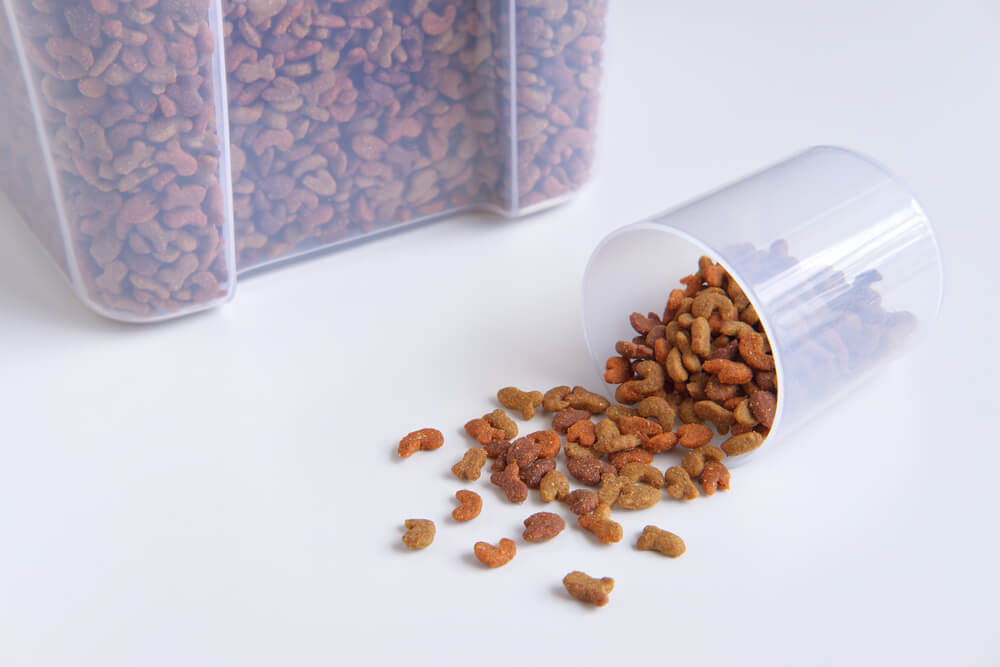Best Dog Food Storage

DogFoodAdvisor is reader supported See how
Dog Food Advisor is 100% impartial and is never paid to promote any brand. But if you buy using links on this page, we may earn a referral fee.
It’s unlikely poring over the perks and pitfalls of dog food containers featured prominently in your dreams of sharing a life with a dog, but it’s an important decision nonetheless.
The good news is, if you do it wisely, choosing dog food storage is something you only have to do once. The less good news is, there’s no one-size-fits-all container and a whole range of factors come into play when making your selection.
How do I store wet dog food?
Due to the amount of moisture in the recipes, wet dog food can spoil quickly and has a shorter lifespan than dry alternatives once opened. That’s why it comes in portion-size cans or pouches, rather than huge bags.
If for whatever reason you need to store wet dog food out of its original packaging — say, your dog’s feeding needs don’t extend to a whole can — it’s possible to keep it safely in the fridge. You can use a small food-grade plastic container with an airtight lid to stop bacteria from getting in and the dog food’s unique scent from lingering among your groceries.
Different brands will have different recommendations on how long wet dog food stored correctly in the fridge will last, but as a general rule of thumb, treat it the same as the leftovers from your own cooking.
If you’d turn your nose up at something that’s been kicking about at the back for longer than four days, your dog probably will too and it’s time to open up a fresh can or pouch.
What’s the best way to store dry dog food?
Dry dog food gives you the freedom to choose a much larger container — a barrel, bin or tub, for instance — as it’ll stay fresh for much longer when kept in a cool, dry place.
Some of these receptacles are so big that they have wheels on the bottom to cart around, which is especially useful for the elderly and disabled.
One thing you need to look out for — and test yourselves before buying preferably — is an airtight lid. This prevents food from going stale quicker than it otherwise would and can also lock in the smell of dog food, which can be rather overpowering, especially in enclosed spaces.
An airtight lid also protects against pests, such as bugs and rodents, as well as greedy pets. Say a larger dog manages to tip a container onto its side — you want the lid to hold firm to ensure they don’t wolf down a week’s supply in the space of seconds. Trust us, some will.
Oh, and if you need help deciding what type of food to fill your dog food container with, read our reviews of the best dog foods.
What’s the best dog food storage container?
Another thing to weigh up is a dog food storage container’s material. Plastic is probably the most popular option, as it’s cheap and long-lasting. It’s also easy to clean, which is something you should do regularly to stop nasty germs from multiplying inside and potentially making your dog sick.
The bulk of plastic containers on the market will be safe — after all, we humans use plastic to store ingredients and meals — but there are things to look out for.
The presence of BPA (otherwise known as bisphenol A) is the main one. Studies have found this industrial chemical can seep into food and liquid, but the long-term health outcomes of consuming BPA aren’t wholly known.
You might judge it to be better safe than sorry and it’s easy to find BPA-free dog food containers, as well as those made out of materials deemed ‘food-grade’ or ‘food-safe’ — polypropylene and polyethylene terephthalate are two common examples.
What other materials can I choose?
At the same time, it’s possible to bypass plastic altogether if you prefer, although alternative dog food storage options are likely to be more expensive.
For some, dog food containers made of glass or stainless steel are more pleasing to the eye and maybe even worthy of a place in an immaculately designed kitchen. If you haven’t got space for a big container, how about a smaller one just for treats?
As well as looking the part, they’re also just as easy to clean and pretty durable, too. Just remember, look for an airtight lid.
Should I pour dog food straight into the container?
Whichever style of dog food container you end up deciding upon, it’s best practice to keep hold of the food’s original packaging. That way, you won’t lose track of the expiry date and you’ll have the manufacturer’s details and ingredient list to hand just in case.
Some dog parents decide to put the whole bag inside the container, which also has the advantage of being generally more hygienic. There’s no best way to store dog food — it’s a matter of finding the best way for you depending on space and resources and finding the best airtight dog food storage system for your needs.
Final word
The Dog Food Advisor does not accept money, gifts, samples or other incentives in exchange for special consideration in preparing our reviews.
However, we do receive a referral fee from online retailers (like Chewy or Amazon) and from sellers of perishable pet food when readers click over to their websites from ours. This helps cover the cost of operation of our free blog. Thanks for your support.
For more information, please visit our Disclaimer and Disclosure page.





